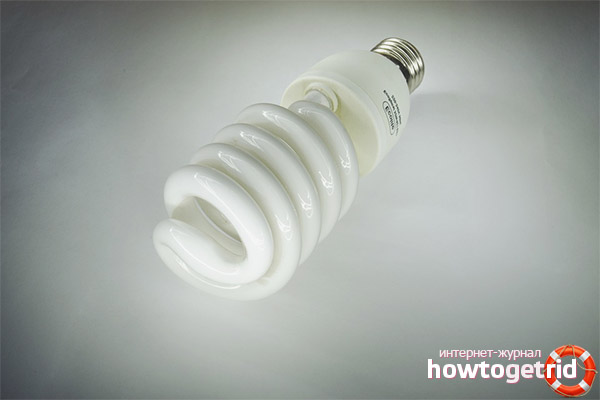The content of the article
There are many versatile opinions on energy-saving lamps. There are both supporters of them and ardent opponents. This article summarizes all the available information about them, provides the advantages and disadvantages of such lamps, which will allow us to draw a definite conclusion about their usefulness.
An energy-saving lamp is an analogue of lamps installed in offices, which are called "fluorescent tubes." In fact, this is exactly the same tube, which is made in the form of a spiral or a snake, having a pair of mercury inside. On the outside, the tube is treated with a phosphor. Under the influence of electric discharges, mercury vapors intensively emit UV rays. This leads to the emission of light by the phosphor. Inside the base of such a lamp is electronic ballasts (or, briefly, electronic ballasts), due to which such a lamp is launched.
Advantages
First, let's focus on the positive aspects:
- Their high durability. The manufacturers themselves directly declare that the energy-saving lamp is ready to last for 10-12 thousand hours. The market presents to the consumer lamps with different levels of quality, therefore, in the average time it will be more correct to take 7-8 thousand hours. It is worth noting that ordinary lamps most often serve no more than 1 thousand hours, and on average this figure does not exceed 650-750 hours.
- Low electricity consumption. Everywhere it is indicated that lamps of this type can consume five times less energy. Also, manufacturers claim that a 12-watt energy-saving lamp will illuminate a room with the same strength as an ordinary lamp with a power of 60 watts. Such indicators can be slightly overestimated, but the difference in power by 3-4 times between different lamps is quite real.
- Warranty from the factory for fluorescent lamps. Rarely do situations arise that require really contacting the warranty period to replace the lamp, but this is possible in fact. Conventional “Ilyich bulbs” are not replaced at all under warranty.
- Such lamps lack a stroboscopic effect, which allows to obtain a constant stream of light even if the voltage "jumps". Under such conditions, eye fatigue is significantly reduced during prolonged use of a personal computer.
- These lamps are practically not heated, so they can be used in places where there is a temperature limit.
Negative sides
Disadvantages of energy-saving lamps:
- Significant price. The cost of one such light bulb can reach 90 rubles for domestic or Chinese copies. With regards to imported lamps, the price for them is about 180 rubles. Using lamps of different production, we can conclude that domestic products are quite competitive and have good quality.
- The lamp tube has mercury vapor inside it, so it is absolutely forbidden to break such a lamp. If this happened, it is recommended to urgently ventilate the room.
- The base of the described lamps is usually a little larger than the usual incandescent lamps, so not in every interior such a lamp will look organic. In some fixtures, they simply can not be installed.
- Not every person will enjoy the light that a fluorescent lamp emits. Many people believe that the color emitted by an ordinary lamp is partly filled with yellow, and energy-saving lamps produce pure white, which is not comfortable for everyone.
Unpleasant fact
Lamps of new generations, in comparison with ordinary ones, produce brighter light.The British Association of Dermatologists provides data according to which it can harm people who have a high level of photosensitivity of the skin. According to scientists, the use of energy-saving lamps can result in a person who has skin diseases, harm, up to skin cancer, and also cause migraines.
How to handle an energy-saving lamp
In order not to encounter negative consequences when using such lamps, it is necessary to follow a number of strict recommendations and mandatory requirements.
- It is immediately worthwhile to understand that handle a fragile lamp with extreme caution. Maximum attention should be paid to this when transporting the product, installing or removing it. For such manipulations, hold the lamp by the housing made of plastic. In particular, this is true for models that have a thin tube. It is also necessary to carefully work with shades that have a narrow neck, as you may encounter problems installing the lamp.
- Remember the important thing: energy-saving lamps negatively relate to frequent shutdowns and ons. A luminaire with a power below 13 W can almost never be turned off. They work without problems throughout the day, because due to constant switching on, the lamp life is reduced, which leads to unnecessary costs.
- If in some places in the apartment you plan to turn on the lamp frequently, then you can use lamps in this situation that have the possibility of a smooth start. This may not always be convenient, but the service life will invariably be extended. Before purchasing, you should ask the seller about the availability of such a function.
So, the main advantages of an energy-saving lamp are its high durability and low level of electricity consumption. It is advisable to purchase lamps that are three times lower in power: instead of 0.060 watts, you should take 0.020 watts. If you translate this into hours of operation, the difference between the lamps will turn out at about 280 kW / h for 7 thousand hours. If we take as a basis the fact that one kilowatt costs three rubles, then direct savings are 840 rubles. from one lamp.
Also, fluorescent lamps have a reduced level of electricity consumption, from this it becomes clear that the level of load on the electric network is reduced. Accordingly, the risk of interruptions, “knocking out” of plugs and short circuits is reduced.
If we take into account all of the above information, we can conclude that sometimes it is advisable to spend money once, but in the future to save and not spend too much time replacing the lamps. At the same time, it should be remembered that with a high level of photosensitivity of the skin, the ability to save for you is not so advisable. And it’s more logical, if you trust the warnings of scientists, use ordinary lamps as before.
Video: how to properly dispose of energy-saving light bulbs











Submit